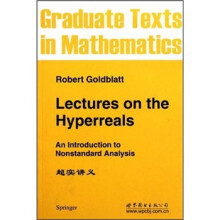超实讲义

目 录内容简介
1foundations
1 what are the hyperreals?
1.1 infinitely small and large
1.2 historical background
1.3 what is a real number?
1.4 historical references
2 large sets
2.1 infinitesimals as variable quantities
2.2 largeness
2.3 filters
2.4 examples of filters
2.5 facts about filters
2.6 zorn's lemma
2.7 exercises on filters
3 ultrapower construction of the hyperreals
3.1 the ring of real-valued sequences
3.2 equivalence modulo an ultrafilter
3.3 exercises on almost-everywhere agreement
3.4 a suggestive logical notation
3.5 exercises on statement values
3.6 the ultrapower
3.7 including the reals in the hyperreals
3.8 infinitesimals and unlimited numbers
3.9 enlarging sets
3.10 exercises on enlargement
3.11 extending functions
3.12 exercises on extensions
3.13 partial functions and hypersequences
3.14 enlarging relations
3.15 exercises on enlarged relations
3.16 is the hyperreal system unique?
4 the transfer principle
4.1 transforming statements
4.2 relational structures
4.3 the language of a relational structure
4.4 *-transforms
4.5 the transfer principle
4.6 justifying transfer
4.7 extending transfer
5 hyperreals great and small
5.1 (un)limited, infinitesimal, and appreciable numbers
5.2 arithmetic of hyperreals
5.3 on the use of "finite" and "infinite"
5.4 halos, galaxies, and real comparisons
5.5 exercises on halos and galaxies
5.6 shadows
5.7 exercises on infinite closeness
5.8 shadows and completeness
5.9 exercise on dedekind completeness
5.10 the hypernaturals
5.11 exercises on hyperintegers and primes
5.12 on the existence of infinitely many primes
ii basic analysis
6 convergence of sequences and series
6.1 convergence
6.2 monotone convergence
6.3 limits
6.4 boundedness and divergence
6.5 cauchy sequences
6.6 cluster points
6.7 exercises on limits and cluster points
6.8 limits superior and inferior
6.9 exercises on lim sup and lim inf
6.10 series
6.11 exercises on convergence of series
7 continuous functions
7.1 cauchy's account of continuity
7.2 continuity of the sine function
7.3 limits of functions
7.4 exercises on limits
7.5 the intermediate value theorem
7.6 the extreme value theorem
7.7 uniform continuity
7.8 exercises on uniform continuity
7.9 contraction mappings and fixed points
7.10 a first look at permanence
7.11 exercises on permanence of functions
7.12 sequences of functions
7.13 continuity of a uniform limit
7.14 continuity in the extended hypersequence
7.15 was cauchy right?
8 differentiation
8.1 the derivative
8.2 increments and differentials
8.3 rules for derivatives
8.4 chain rule
8.5 critical point theorem
8.6 inverse function theorem
8.7 partial derivatives
8.8 exercises on partial derivatives
8.9 taylor series
8.10 incremental approximation by taylor's formula
8.11 extending the incremental equation
8.12 exercises on increments and derivatives
9 the riemann integral
9.1 riemann sums
9.2 the integral as the shadow of riemann sums
9.3 standard properties of the integral
9.4 differentiating the area function
9.5 exercise on average function values
10 topology of the reals
10.1 interior, closure, and limit points
10.2 open and closed sets
10.3 compactness
10.4 compactness and (uniform) continuity
10.5 topologies on the hyperreals
iii internal and external entities
11 internal and external sets
11.1 internal sets
11.2 algebra of internal sets
11.3 internal least number principle and induction
11.4 the overflow principle
11.5 internal order-completeness
11.6 external sets
11.7 defining internal sets
11.8 the underflow principle
11.9 internal sets and permanence
11.10 saturation of internal sets
11.11 saturation creates nonstandard entities
11.12 the size of an internal set
11.13 closure of the shadow of an internal set
11.14 interval topology and hyper-open sets
12 internal functions and hyperfinite sets
12.1 internal functions
12.2 exercises on properties of internal functions
12.3 hyperfinite sets
12.4 exercises on hyperfiniteness
12.5 counting a hyperfinite set
12.6 hyperfinite pigeonhole principle
12.7 integrals as hyperflnite sums
iv nonstandard frameworks
13 universes and frameworks
13.1 what do we need in the mathematical world?
13.2 pairs are enough
13.3 actually, sets are enough
13.4 strong transitivity
13.5 universes
13.6 superstructures
13.7 the language of a universe
13.8 nonstandard frameworks
13.9 standard entities
13.10 internal entities
13.11 closure properties of internal sets
13.12 transformed power sets
13.13 exercises on internal sets and functions
13.14 external images are external
13.15 internal set definition principle
13.16 internal function definition principle
13.17 hyperfiniteness
13.18 exercises on hyperfinite sets and sizes
13.19 hyperfinite summation
13.20 exercises on hyperfinite sums
14 the existence of nonstandard entities
14.1 enlargements
14.2 concurrence and hyperfinite approximation
14.3 enlargements as ultrapowers
14.4 exercises on the ultrapower construction
15 permanence, comprehensiveness, saturation
15.1 permanence principles
15.2 robinson's sequential lemma
15.3 uniformly converging sequences of functions
15.4 comprehensiveness
15.5 saturation
v applications
16 loeb measure
16.1 rings and algebras
16.2 measures
16.3 outer measures
16.4 lebesgue measure
16.5 loeb measures
16.6
16.7 loeb measure as approximability
16.8 lebesgue measure via loeb measure
17 ramsey theory
17.1 colourings and monochromatic sets
17.2 a nonstandard approach
17.3 proving p, amsey's theorem
17.4 the finite ramsey theorem
17.5 the paris-harrington version
17.6 reference
18 completion by enlargement
18.1 completing the rationals
18.2 metric space completion
18.3 nonstandard hulls
18.4 p-adic integers
18.5 p-adic numbers
18.6 power series
18.7 hyperfinite expansions in base p
18.8 exercises
19 hyperfinite approximation
19.1 colourings and graphs
19.2 boolean algebras
19.3 atomic algebras
19.4 hyperfinite approximating algebras
19.5 exercises on generation of algebras
19.6 connecting with the stone representation
19.7 exercises on filters and lattices
19.8 hyperfinite-dimensional vector spaces
19.9 exercises on (hyper) real suhspaces
19.10 the hahn-banach theorem
19.11 exercises on (hyper) linear functionals
20 books on nonstandard analysis
index
1 what are the hyperreals?
1.1 infinitely small and large
1.2 historical background
1.3 what is a real number?
1.4 historical references
2 large sets
2.1 infinitesimals as variable quantities
2.2 largeness
2.3 filters
2.4 examples of filters
2.5 facts about filters
2.6 zorn's lemma
2.7 exercises on filters
3 ultrapower construction of the hyperreals
3.1 the ring of real-valued sequences
3.2 equivalence modulo an ultrafilter
3.3 exercises on almost-everywhere agreement
3.4 a suggestive logical notation
3.5 exercises on statement values
3.6 the ultrapower
3.7 including the reals in the hyperreals
3.8 infinitesimals and unlimited numbers
3.9 enlarging sets
3.10 exercises on enlargement
3.11 extending functions
3.12 exercises on extensions
3.13 partial functions and hypersequences
3.14 enlarging relations
3.15 exercises on enlarged relations
3.16 is the hyperreal system unique?
4 the transfer principle
4.1 transforming statements
4.2 relational structures
4.3 the language of a relational structure
4.4 *-transforms
4.5 the transfer principle
4.6 justifying transfer
4.7 extending transfer
5 hyperreals great and small
5.1 (un)limited, infinitesimal, and appreciable numbers
5.2 arithmetic of hyperreals
5.3 on the use of "finite" and "infinite"
5.4 halos, galaxies, and real comparisons
5.5 exercises on halos and galaxies
5.6 shadows
5.7 exercises on infinite closeness
5.8 shadows and completeness
5.9 exercise on dedekind completeness
5.10 the hypernaturals
5.11 exercises on hyperintegers and primes
5.12 on the existence of infinitely many primes
ii basic analysis
6 convergence of sequences and series
6.1 convergence
6.2 monotone convergence
6.3 limits
6.4 boundedness and divergence
6.5 cauchy sequences
6.6 cluster points
6.7 exercises on limits and cluster points
6.8 limits superior and inferior
6.9 exercises on lim sup and lim inf
6.10 series
6.11 exercises on convergence of series
7 continuous functions
7.1 cauchy's account of continuity
7.2 continuity of the sine function
7.3 limits of functions
7.4 exercises on limits
7.5 the intermediate value theorem
7.6 the extreme value theorem
7.7 uniform continuity
7.8 exercises on uniform continuity
7.9 contraction mappings and fixed points
7.10 a first look at permanence
7.11 exercises on permanence of functions
7.12 sequences of functions
7.13 continuity of a uniform limit
7.14 continuity in the extended hypersequence
7.15 was cauchy right?
8 differentiation
8.1 the derivative
8.2 increments and differentials
8.3 rules for derivatives
8.4 chain rule
8.5 critical point theorem
8.6 inverse function theorem
8.7 partial derivatives
8.8 exercises on partial derivatives
8.9 taylor series
8.10 incremental approximation by taylor's formula
8.11 extending the incremental equation
8.12 exercises on increments and derivatives
9 the riemann integral
9.1 riemann sums
9.2 the integral as the shadow of riemann sums
9.3 standard properties of the integral
9.4 differentiating the area function
9.5 exercise on average function values
10 topology of the reals
10.1 interior, closure, and limit points
10.2 open and closed sets
10.3 compactness
10.4 compactness and (uniform) continuity
10.5 topologies on the hyperreals
iii internal and external entities
11 internal and external sets
11.1 internal sets
11.2 algebra of internal sets
11.3 internal least number principle and induction
11.4 the overflow principle
11.5 internal order-completeness
11.6 external sets
11.7 defining internal sets
11.8 the underflow principle
11.9 internal sets and permanence
11.10 saturation of internal sets
11.11 saturation creates nonstandard entities
11.12 the size of an internal set
11.13 closure of the shadow of an internal set
11.14 interval topology and hyper-open sets
12 internal functions and hyperfinite sets
12.1 internal functions
12.2 exercises on properties of internal functions
12.3 hyperfinite sets
12.4 exercises on hyperfiniteness
12.5 counting a hyperfinite set
12.6 hyperfinite pigeonhole principle
12.7 integrals as hyperflnite sums
iv nonstandard frameworks
13 universes and frameworks
13.1 what do we need in the mathematical world?
13.2 pairs are enough
13.3 actually, sets are enough
13.4 strong transitivity
13.5 universes
13.6 superstructures
13.7 the language of a universe
13.8 nonstandard frameworks
13.9 standard entities
13.10 internal entities
13.11 closure properties of internal sets
13.12 transformed power sets
13.13 exercises on internal sets and functions
13.14 external images are external
13.15 internal set definition principle
13.16 internal function definition principle
13.17 hyperfiniteness
13.18 exercises on hyperfinite sets and sizes
13.19 hyperfinite summation
13.20 exercises on hyperfinite sums
14 the existence of nonstandard entities
14.1 enlargements
14.2 concurrence and hyperfinite approximation
14.3 enlargements as ultrapowers
14.4 exercises on the ultrapower construction
15 permanence, comprehensiveness, saturation
15.1 permanence principles
15.2 robinson's sequential lemma
15.3 uniformly converging sequences of functions
15.4 comprehensiveness
15.5 saturation
v applications
16 loeb measure
16.1 rings and algebras
16.2 measures
16.3 outer measures
16.4 lebesgue measure
16.5 loeb measures
16.6
16.7 loeb measure as approximability
16.8 lebesgue measure via loeb measure
17 ramsey theory
17.1 colourings and monochromatic sets
17.2 a nonstandard approach
17.3 proving p, amsey's theorem
17.4 the finite ramsey theorem
17.5 the paris-harrington version
17.6 reference
18 completion by enlargement
18.1 completing the rationals
18.2 metric space completion
18.3 nonstandard hulls
18.4 p-adic integers
18.5 p-adic numbers
18.6 power series
18.7 hyperfinite expansions in base p
18.8 exercises
19 hyperfinite approximation
19.1 colourings and graphs
19.2 boolean algebras
19.3 atomic algebras
19.4 hyperfinite approximating algebras
19.5 exercises on generation of algebras
19.6 connecting with the stone representation
19.7 exercises on filters and lattices
19.8 hyperfinite-dimensional vector spaces
19.9 exercises on (hyper) real suhspaces
19.10 the hahn-banach theorem
19.11 exercises on (hyper) linear functionals
20 books on nonstandard analysis
index
目 录内容简介
《超实讲义》是一部讲述非标准分析的入门教程,是由作者数年教学讲义发展并扩充而成。具备基本分析知识的高年级本科生,研究生以及自学人员都可以完全读懂。非标准分析理论不仅是研究无限大和无限小的强有力的理论,也是一种截然不同于标准数学概念和结构的方法,更是新的结构,目标和证明的源泉,推理原理的新起点。书中是从超实数系统开始,从非标准的角度讲述单变量积分,分析和拓扑,着重强调变换原理作为一个重要的数学工具的重要作用。数学宇宙的讲述为全面研究非标准方法论提供了基础保证。最后一章着眼于应用,将这些理论应用于loeb测度理论及其与lebesgue的一些关系,ramsey定理,p-进数的非标准结构和幂级数,boolean代数的stone表示定理的非标准证明和hahn-banach定理。《超实讲义:英文(影印版)》的最大特点尽早引入内集,外集,超有限集,以及集理论扩展方法,较常规的建立在超结构基础上,这样的方式更加显而易见。
比价列表
1人想要
公众号、微信群
 缺书网
缺书网微信公众号
 扫码进群
扫码进群实时获取购书优惠






